Sphinginae subfamily
Sphingini tribe:
 |
Agrius cingulata
stray,
Pink-spotted Hawkmoth
stray
This moth is a very strong flier, but would only make its way to
Quebec as a rare stray.
|
 |
Ceratomia amyntor
occasional,
the Elm Sphinx or Four-horned Sphinx
The upperside of the forewing is brown with dark brown and white markings including a white costal area near the wing base,
dark streaks along the veins, and a white spot in the cell.
|
 |
The upperside of the forewing is yellowish brown with no white markings, but there are indistinct black lines and dashes. The cell spot is gray with a black outline. The larvae feed in large groups and are much more
spectacular than the moths.
Catalpa is the larval host.
might be a casual breeder in south; unlikely |
 |
The upperside of the forewing is pale brownish gray with wavy black
and white lines and a black-outlined white cell spot. The upperside
of the hindwing is gray with diffuse darker bands.
|
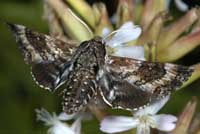 |
Dolba hyloeus
present, the Pawpaw Sphinx
The upperside of the forewing is dark brown with a dusting of white
scales. Some moths have patches of reddish or yellowish brown on the
wings.
|
 |
If you have pines, you probably have this species. It flies on P.E.I.
|
 |
The upperside of the forewing is gray-brown with wavy lines, black
dashes, and one or two small white spots near the center of the costa.
|
 |
Manduca quinquemaculatus
rare,
the Five-spotted Hawkmoth
The moth abdomen usually has five but sometimes six pairs of yellow
bands. The upperside of the forewing is blurry brown and gray.
I suspect if you grow tomatoes, you are likely to encounter it.
|
 |
Look for three large yellow spots
on each side of the abdomen. The upperside of the forewing is
yellowish brown to deep chocolate brown with a dusting of white
scales and zigzagged black and white lines.
|

|
Sphinx canadensis
rare,
Sphinx canadensis, the Canadian Sphinx, is not common, and is not
often reported anywhere,
but it might be present in Ontario County as it is reported from
southern Ontario, Canada.
Larval hosts are white ash (Fraxinus americana) and blueberry
(Vaccinium).
|
 |
Sphinx chersis
occasional, the Northern Ash Sphinx or
Great Ash SphinxThis species is present and is probably common.
Larval hosts are ash, lilac, privet, cherry, and quaking
aspen.
|
 |
This species is officially reported in Quebec. We have them
on P.E.I., but I do not see them nearly as frequently
as I see the other Sphingidae.
|
 |
Sphinx gordius
probably common as poecila, the
Apple Sphinx
The upperside of the forewing ranges from brown with black borders
through brownish gray with paler borders to pale gray with no
borders. |
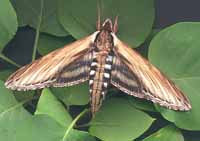 |
The lower forewings are predominantly brownish-yellow with a fairly
wide dark bar along the inner margin. At rest the wings hug the body,
giving the moth a long slender look.
|
 |
Sphinx luscitiosa
rare,
the Canadian Sphinx or
Clemen's Sphinx
This one is reported from Quebec, but it is generally not common.
|
 |
Sphinx poecila
abundant, the Poecila Sphinx
If you have blueberries in the woods, then you might have the
Poecila Sphinx.
They are pretty common here on Prince Edward Island.
|
Smerinthini Tribe:
 |
Amorpha juglandis
common in south,
the Walnut Sphinx
The adults are also highly variable; sometimes wings of an individual
may be all one color or may have several colors, ranging from pale to
dark brown, and may have a white or pink tinge.
See the file for the female; she is different.
|
 |
Pachysphinx modesta
common,
the Modest Sphinx or Poplar Sphinx
This moth is recorded regularly in Ontario. Its larvae are
fond of poplars and
willows.
They are common on Prince Edward Island.
|
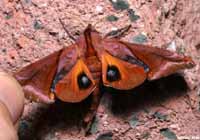 |
Paonias astylus, the Huckleberry Sphinx (wingspan 55-65 mm), ranges
from Maine south to Florida, west to Missouri and Mississippi.
very rare
|
 |
Named for the dull grey-blue spot (minus dark pupil) in the hindwing,
this moth has a wide distribution and is common in Ontario.
I regularly see them on Prince Edward Island, and they are reported
as far south as Florida. |
 |
Paonias myopscommon, the Small-eyed Sphinx
Named for the small eye-spot in the hindwing, this moth has a wide
distribution and is probably common in Ontario.
I regularly see them on Prince Edward Island, and they are reported
as far south as Florida.
|
 |
Smerinthus cerisyi
common,
the Cerisyi's Sphinx
Smerinthus cerisyi is found in the southern regions of all Canadian
provinces and in northern border states. The one-eyed sphinx is also
found along the U.S. west coast, eastward to the Rockies. At my home
in Montague, P.E.I., Canada, they are quite common.
|
 |
This moth is widely distributed and fairly common.
Along the East Coast, it flies from P.E.I. to Florida. I suspect it
is present. |
Macroglossinae subfamily
Dilophonotini tribe:
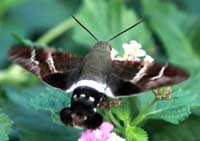 |
Aellopos titan
rare migrant, the Titan Sphinx.
possible stray
The body is dark brown with a wide white stripe across the abdomen.
The wings are dark brown. It is very similar to above species, but the
upperside of the hindwing has
pale patches along the costa and inner margin. |
 |
Erinnyis ello rare migrant, the Ello Sphinx
This species is reported in Maricopa County and in other southern Arizona counties.
Males and females differ.
|
See Hemaris comparison to help distinguish
the next four species.
 |
Hemaris thysbe
common, the Hummingbird Clearwing
It is not difficult to see why many gardeners would mistake an
Hemaris thysbe moth for a small hummingbird as it hovers,
sipping nectar from flowers through a long feeding tube.
|
Hemaris thysbe, Champlain Lookout, Gatineau Park, Quebec, June 3, 2011, Giorgio Zanetti.
Hemaris thysbe, Gouin Reservoir, northern Quebec, July 5, 2010, Neil Cameron.
Hemaris thysbe nectaring at pink phlox, Aylmer,
Gatineau, August 2, 2010, Michel Paradis.
Hemaris thysbe nectaring at pink phlox, Laurentian,
August 2-15, 2010, courtesy of Ilania Abileah.
 |
Hemaris aethra
common.
Note large orangey-brown forewing apical patch. In very similar H. diffinis patch is smaller.
On average H. aethra, compared to H. diffinis, tends to be slightly larger, with more orangey-yellow tone,
less tapering (top to bottom) of dark thorax/abdominal region; more red nr hw anal angle.
|
Hemaris aethra, Val des Monts, north of Gatineau, June 2012, Nancy.
 |
Hemaris diffinis
common, the
Snowberry Clearwing or Bumblebee Moth
Adults mimic bumblebees and are quite variable. The wings are
basically clear, with dark brown to brownish-orange veins, bases
and edges. The thorax is golden-brown to dark greenish-brown with
1-2 yellow segments on the abdomen.
|
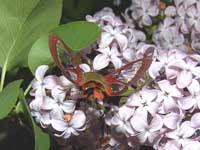 |
Hemaris gracilis
rare, the
Slender Clearwing or Graceful Clearwing
This day-flying moth is less common.
|
Philampelini tribe:
 |
This moth is reported for Ontario, and it is fairly often reported
along the east coast from southern New Jersey
to central Maine.
Note the differences between this moth and the Pandorus Sphinx.
|
 |
Eumorpha fasciatus
rare migrant, the Banded Sphinx
The upperside of the moth is dark pinkish brown. Each forewing has a
lighter brown band along the costa, and sharp pinkish white bands and
streaks. Larvae feed upon primrose-willow, Ludwigia (water primrose)
and other plants in the evening primrose family.
|
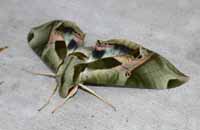 |
If you have Grape or Virginia Creeper nearby, then you probably have
this species.
I often get asked to identify larvae from areas not
previously reported.
|
Macroglossini tribe:
 |
This day flier is widely distributed. If you have Virginia Creeper,
you probably have the Nessus Sphinx. It is officially reported
from Ontario.
Two bright, distinct, narrow yellow
bands are often visible on the abdomen.
|
 |
They are common in New Jersey and common
here on Prince Edward Island.
You will often see this species listed as Darapsa pholus,
especially in older literature.
It is confirmed for Ontario.
|
 |
Darapsa myron
present, the Virginia Creeper Sphinx or the
Grapevine Sphinx
It is widely reported as far north as southern Maine. If you have the
foodplants indicated in the common names, you probably have this
species nearby. |
 |
If you have hydrangea growing near a stream, then you may have the
Hydrangea Sphinx.
|
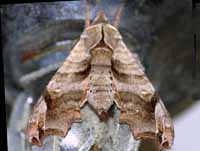 |
This species has been recorded in Quebec, and it is an early
season flier.
Larvae feed on grape foliage and on Virginia Creeper.
|
 |
Hyles euphorbiae
introduced,
the Leafy Spurge Hawkmoth
This species has been introduced into Ontario to try to control
the spread of leafy spurge.
|
 |
Hyles gallii
present, the Bedstraw Hawk Moth
or Gallium Sphinx
This species is reported in Quebec.
Some years I see them on P.E.I., some years, I do not.
|
 |
Hyles lineata
irregular migrant, the White-lined Sphinx
This species is reported from Ontario. It flies across
southern New York and has strong migrating tendancies.
There are records from New Hampshire and Maine. |
 |
This day flier is officially reported from Quebec, but it
maynot be common. Look for them in meadows near coniferous forests.
|
 |
This moth is very much under reported across the United States
and Canada. It
is a rapid day flier so is probably not in too many collections.
Grape is a popular larval host.
|
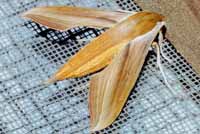 |
Xylophanes tersa
irregular migrant,
the Tersa Sphinx
This moth is much more common to the south. It is a strong migrant,
however, and occasionally flies in Quebec.
|
|
|

